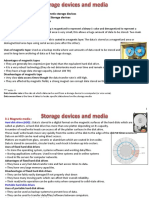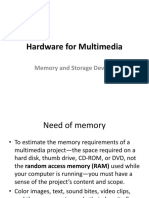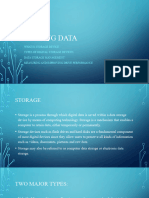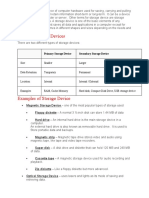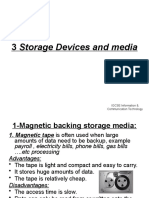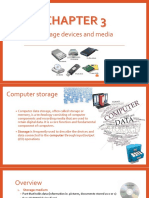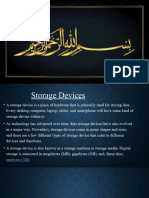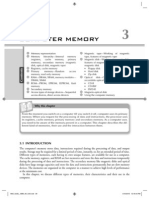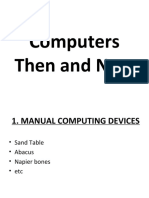0 ratings0% found this document useful (0 votes)
41 viewsStorage Devices & Media
Storage Devices & Media
Uploaded by
7FDhrisha GadaThe document discusses different types of storage devices and media, including optical media like CDs, DVDs, and Blu-ray discs, as well as solid-state devices like SSDs, memory cards, and USB drives. Optical media stores data digitally using lasers to read from the disk, while solid-state devices have no moving parts and use flash memory. Common uses of these storage methods include storing files, photos, music and videos; installing software; and transferring data between devices.
Copyright:
© All Rights Reserved
Available Formats
Download as PPTX, PDF, TXT or read online from Scribd
Storage Devices & Media
Storage Devices & Media
Uploaded by
7FDhrisha Gada0 ratings0% found this document useful (0 votes)
41 views12 pagesThe document discusses different types of storage devices and media, including optical media like CDs, DVDs, and Blu-ray discs, as well as solid-state devices like SSDs, memory cards, and USB drives. Optical media stores data digitally using lasers to read from the disk, while solid-state devices have no moving parts and use flash memory. Common uses of these storage methods include storing files, photos, music and videos; installing software; and transferring data between devices.
Copyright
© © All Rights Reserved
Available Formats
PPTX, PDF, TXT or read online from Scribd
Share this document
Did you find this document useful?
Is this content inappropriate?
The document discusses different types of storage devices and media, including optical media like CDs, DVDs, and Blu-ray discs, as well as solid-state devices like SSDs, memory cards, and USB drives. Optical media stores data digitally using lasers to read from the disk, while solid-state devices have no moving parts and use flash memory. Common uses of these storage methods include storing files, photos, music and videos; installing software; and transferring data between devices.
Copyright:
© All Rights Reserved
Available Formats
Download as PPTX, PDF, TXT or read online from Scribd
Download as pptx, pdf, or txt
0 ratings0% found this document useful (0 votes)
41 views12 pagesStorage Devices & Media
Storage Devices & Media
Uploaded by
7FDhrisha GadaThe document discusses different types of storage devices and media, including optical media like CDs, DVDs, and Blu-ray discs, as well as solid-state devices like SSDs, memory cards, and USB drives. Optical media stores data digitally using lasers to read from the disk, while solid-state devices have no moving parts and use flash memory. Common uses of these storage methods include storing files, photos, music and videos; installing software; and transferring data between devices.
Copyright:
© All Rights Reserved
Available Formats
Download as PPTX, PDF, TXT or read online from Scribd
Download as pptx, pdf, or txt
You are on page 1of 12
Storage Devices & Media
GADA DHRISHA RAJESH
9F08
IN462
Optical Media & Optical Storage Devices
• CD-R & DVD-R are used to store data to be kept for later
use or to be transferred to another computer.
• CD-RW & DVD-RW are used to record television
programs which can be recorded over, time and time
again (although increasingly replaced by HDD recording
systems).
• CD-ROMs and DVD-ROMs are used in applications
where there is a real need to prevent the deletion or
overwriting of important data.
• Blu-ray discs are another example of optical storage
media.
Solid-State Media & Solid-State Storage Devices
• Floating gate and control gate transistors use CMOS (complementary metal oxide
semi-conductor) NAND technology.
• Solid-state drives have revolutionized computers over the last few years, and they
are rapidly taking over from HDDs as the main type of backing storage.
• Pen drives (memory sticks) are small portable devices that make use of solid-state
technology.
• A memory card makes use of solid-state technology. They can be inserted into a
device which can read the card or allow data to be written to the card.
Explain what is meant by the term ‘Optical
Media’.
• Optical media refers to any data storage device or
equipment that uses optical data storage and
retrieval techniques to read and write data.
• It stores data digitally on a media device and uses a
laser to read data from it.
• Optical media is also known as optical storage.
• Optical media provides more data capacity and
longer media device life than earlier methods of
data storage.
Uses of SSDs
• Solid-state drives have revolutionized computers
over the last few years, and they are rapidly taking
over from HDDs as the main type of backing storage.
• As the name suggests, they use solid-state media
and can be used in the same way as an HDD.
• They have enabled laptop computers to become
thinner and much lighter.
• They have given rise to the development of
smartphones and tablets; without solid-state
technology, these devices simply would not exist.
Uses Of HDDs
• To store the operating system, systems software
and working data/files.
• Used in real-time systems (for example, robots,
control of a chemical plant) and in online systems
(for example, booking airline tickets, automatic
stock control (using EPOS)).
• They can be used as backup systems to prevent loss
of data.
• They can be used to transfer data/files/software
between computers.
Uses Of Blu-Ray Discs
• Storing and playing back movies (one
high definition movie of two hours
duration uses up 25 GB of memory).
• Home video consoles.
• Computers can use this technology for
data storage or backing up hard drives.
• Camcorders can use this media (in
cartridge form) to store movies.
Uses Of Memory Cards
• Storing photos on digital cameras.
• Used as mobile phone memory
cards.
• Used in MP3 players to store
music files.
• Used as a backing store in hand-
held computer devices.
Uses of CD-R and DVD-R
• Home recordings of music (CD-
R) and films (DVD-R).
• Used to store data to be kept for
later use or to be transferred to
another computer.
Uses of CD-RW/DVD-RW
• Used to record television
programs which can be recorded
over, time and time again
(although increasingly replaced
by HDD recording systems).
• Used in CCTV systems.
• Can be used as a backup device
for files and data.
Uses of CD-ROM/DVD-ROM
• These optical disks are read-only memory (ROM) which
means they cannot be written over and can only be
read. They are a permanent method of data storage.
• CD-ROM is used to store music files and to store
software, computer games and reference software
(such as an encyclopedia).
• DVD-ROM has much larger storage and is used to store
films; but now it is increasingly used to store computer
data and the evermore sophisticated games.
• CD-ROMs and DVD-ROMs are used in applications
where there is a real need to prevent the deletion or
overwriting of important data.
Uses of memory sticks/pen drives
• Transporting files between computers or
using as a backing store.
• Used as a security device to prevent
software piracy (known as a dongle).
You might also like
- IGCSE ICT Ch3 StoragedevicesandmediaDocument32 pagesIGCSE ICT Ch3 StoragedevicesandmediaEssential CenterNo ratings yet
- CH 3 Worksheet 2 (Autosaved)Document4 pagesCH 3 Worksheet 2 (Autosaved)Jawad HussainNo ratings yet
- Data StorageDocument37 pagesData StorageMheiy Anyayahan - AlcantaraNo ratings yet
- Storage Devices and MediaDocument5 pagesStorage Devices and MedialameckNo ratings yet
- Storage Devices and MediaDocument18 pagesStorage Devices and Mediaapi-262367281No ratings yet
- Section 3 Storage Devices and MediaDocument6 pagesSection 3 Storage Devices and Mediaiqrakhan.avicennaNo ratings yet
- Ict Project Vivi 9ADocument31 pagesIct Project Vivi 9AVivi ChenNo ratings yet
- Storage DevicesDocument48 pagesStorage DevicesChazia ZNo ratings yet
- Storage Devices and MediaDocument15 pagesStorage Devices and MediaAgney DhanapuneNo ratings yet
- Storage Devices: Mohit Kumar Pandey Mohit NeheteDocument31 pagesStorage Devices: Mohit Kumar Pandey Mohit NeheteMohit pandeyNo ratings yet
- Class 9 Chapter 2 (Part-1)Document21 pagesClass 9 Chapter 2 (Part-1)anjumjamal8174No ratings yet
- 3.storage Devices and MediaDocument6 pages3.storage Devices and Mediahello ManeNo ratings yet
- Chapter 3 Data Storage ProDocument7 pagesChapter 3 Data Storage Proekanshtoocaram8No ratings yet
- Theory Ch3 PDFDocument9 pagesTheory Ch3 PDFiman mohamedNo ratings yet
- Platform Technologies - P4Document38 pagesPlatform Technologies - P4Percival FernandezNo ratings yet
- On MemoryDocument34 pagesOn MemoryZuhair Ibne Alam8KNo ratings yet
- Unit 3 Storage Devices and MediaDocument29 pagesUnit 3 Storage Devices and MediaTimoNo ratings yet
- Notes AUGUST 2020 Chapter 3: Storage Devices and Media Grade: 8 Subject: IctDocument8 pagesNotes AUGUST 2020 Chapter 3: Storage Devices and Media Grade: 8 Subject: Ictanish kanthethiNo ratings yet
- Secondary Storage in Operating Systems.Document24 pagesSecondary Storage in Operating Systems.muneebmaher012No ratings yet
- Memory Chapter 2Document43 pagesMemory Chapter 2data planetNo ratings yet
- Unit 3 - Storage Devices and MediaDocument7 pagesUnit 3 - Storage Devices and MediaEdwardNo ratings yet
- Auxiliary MemoryDocument24 pagesAuxiliary MemoryDiscock MichaelNo ratings yet
- 3 Storage Devices and MediaDocument7 pages3 Storage Devices and MedianoraNo ratings yet
- Storage Devices & SoftwareDocument18 pagesStorage Devices & SoftwareDAKSH GREAD DPSN-STDNo ratings yet
- Hardware For Multimedia (Storage)Document16 pagesHardware For Multimedia (Storage)SaurabhChaudharyNo ratings yet
- Storage DevicesDocument25 pagesStorage DevicesRufaro MatanhireNo ratings yet
- MMS - Chapter 4 - Optical StorageDocument29 pagesMMS - Chapter 4 - Optical StorageAbebaw GebreNo ratings yet
- Itcs Lec8 - Hardware StorageDocument42 pagesItcs Lec8 - Hardware StorageJulius S. MartinezNo ratings yet
- CSC 170 - Introduction To Computers and Their Applications: Storage BasicsDocument21 pagesCSC 170 - Introduction To Computers and Their Applications: Storage BasicsMuqeemuddin SyedNo ratings yet
- Types of Memory and Storage 2Document16 pagesTypes of Memory and Storage 2gemmaepitongNo ratings yet
- Storage Devices and MediaDocument8 pagesStorage Devices and Mediataha imranNo ratings yet
- Fundamentals OF Information Technology: PresentationDocument21 pagesFundamentals OF Information Technology: PresentationmirzarakeekNo ratings yet
- Lesson 4Document80 pagesLesson 4Princess Rose MendozaNo ratings yet
- Types of Storage Devices: Size Smaller LargerDocument2 pagesTypes of Storage Devices: Size Smaller LargerSuhana Singh100% (1)
- 3 Storage Devices and Media: IGCSE Information & Communication TechnologyDocument14 pages3 Storage Devices and Media: IGCSE Information & Communication TechnologyGhadeer AlshoumNo ratings yet
- Chapter 3Document14 pagesChapter 3Catherine Dharshini LabrooyNo ratings yet
- FIT Presentation NODocument23 pagesFIT Presentation NOmirzarakeekNo ratings yet
- StorageDocument30 pagesStorageEmily ChowNo ratings yet
- DRAFT NARRATIVE - IT TOOLS REPORTING Module 9Document4 pagesDRAFT NARRATIVE - IT TOOLS REPORTING Module 9frenzuaavellanoza1222No ratings yet
- Lesson 4Document27 pagesLesson 4Niña Mae C. QuiambaoNo ratings yet
- Lecture # 7 (09-08-23)Document15 pagesLecture # 7 (09-08-23)Raheel AbbasNo ratings yet
- Chapter 2 (Computer Hardware)Document69 pagesChapter 2 (Computer Hardware)Janelle Cabida SupnadNo ratings yet
- Storage DevicesDocument3 pagesStorage DevicesAko-ang Batang Ekis100% (1)
- Lesson 2Document41 pagesLesson 2Chito A. Florenosos100% (1)
- Identifying Purposes and Characteristics of Storage DevicesDocument81 pagesIdentifying Purposes and Characteristics of Storage DevicesebsenbabaNo ratings yet
- Secondary MemoryDocument17 pagesSecondary MemoryYaniv VinayNo ratings yet
- Chapter 4 - Secondary Storage!Document45 pagesChapter 4 - Secondary Storage!88x7qjtcjbNo ratings yet
- Lecture 8Document38 pagesLecture 8mehnazahmad721No ratings yet
- Chapter 4 - Secondary StorageDocument45 pagesChapter 4 - Secondary StorageNur Amira NadiaNo ratings yet
- Multimedia StorageDocument11 pagesMultimedia StorageAjay Joshy0% (1)
- Ict Igcse Chapter 3 SummaryDocument6 pagesIct Igcse Chapter 3 SummaryEsra Taha100% (1)
- External Memory Ch1Document44 pagesExternal Memory Ch1shanbel ayayuNo ratings yet
- Lesson 7 (Secondary Storage)Document5 pagesLesson 7 (Secondary Storage)siepiner72No ratings yet
- Computers - Storage & Memory Devices: Chapter-1Document30 pagesComputers - Storage & Memory Devices: Chapter-1PrabhaNo ratings yet
- Green Dale International School: Computer Science:ProjectDocument14 pagesGreen Dale International School: Computer Science:ProjectJunayed IslamNo ratings yet
- Compu AssignmentDocument6 pagesCompu Assignmentsyedaesha557No ratings yet
- FOC Unit 1Document45 pagesFOC Unit 1Shambhavi MishraNo ratings yet
- Week 3 Computer Storage Devices-1Document41 pagesWeek 3 Computer Storage Devices-1Anne's ArtNo ratings yet
- Beginner's Guide for Cybercrime InvestigatorsFrom EverandBeginner's Guide for Cybercrime InvestigatorsRating: 5 out of 5 stars5/5 (1)
- Introduction To Computers: Created by Keerti PandeyDocument29 pagesIntroduction To Computers: Created by Keerti PandeyKeerti PandeyNo ratings yet
- M03 Goel 9788131733097 00 C03Document22 pagesM03 Goel 9788131733097 00 C03mohsindalvi87No ratings yet
- Itm Computer FundamentalsDocument26 pagesItm Computer FundamentalsSyed Zaffar NiazNo ratings yet
- Introduction To ComputersDocument92 pagesIntroduction To ComputerspakupaNo ratings yet
- Acer Aspire 5810t 5810tz 5410t 5810tg SeriesDocument152 pagesAcer Aspire 5810t 5810tz 5410t 5810tg SeriesvideosonNo ratings yet
- 17ucse01 - MultimediaDocument91 pages17ucse01 - MultimediaSatheesh KoothanNo ratings yet
- 90AV99001046 PartIcCNG 121211 enDocument57 pages90AV99001046 PartIcCNG 121211 enJose RosarioNo ratings yet
- KDC W434 W4034 W4534 - InsDocument36 pagesKDC W434 W4034 W4534 - Insgabi_xyzNo ratings yet
- Module IDocument25 pagesModule IWillard Jade FaustinoNo ratings yet
- Blu-Ray Disc Seminar Report On 2011-2012: Dept of Computer Engineering 10 G.P.T.C.KaduthuruthyDocument27 pagesBlu-Ray Disc Seminar Report On 2011-2012: Dept of Computer Engineering 10 G.P.T.C.Kaduthuruthygosu320No ratings yet
- Burnintest Linux Users Manual: PassmarkDocument40 pagesBurnintest Linux Users Manual: Passmarkkali hackNo ratings yet
- BSA 1 TrainingDocument305 pagesBSA 1 TrainingSrinidhi RaoNo ratings yet
- Magnetic Tapes Cd-Rom: Adil Yousif, PHDDocument31 pagesMagnetic Tapes Cd-Rom: Adil Yousif, PHDSamahir AlkleefaNo ratings yet
- Computing Fundamentals Module Lesson 2 Computer HardwareDocument53 pagesComputing Fundamentals Module Lesson 2 Computer HardwareAnb BajwaNo ratings yet
- Satellite Pro C840-SP4225KLDocument3 pagesSatellite Pro C840-SP4225KLsafang lifungNo ratings yet
- Acer Aspire 5600, Travelmate 2480, 4220 Service GuideDocument130 pagesAcer Aspire 5600, Travelmate 2480, 4220 Service GuideDoris D QuirinNo ratings yet
- HW SWDocument53 pagesHW SWMahesh KumarNo ratings yet
- C04 ELT ExamsDocument10 pagesC04 ELT ExamsShirin AmirzadehNo ratings yet
- LogDocument4 pagesLogJuan GANo ratings yet
- HP / Compaq 1700xlDocument135 pagesHP / Compaq 1700xlRAM_ArbeitsspeicherNo ratings yet
- Choose The Correct Answer by CrossingDocument11 pagesChoose The Correct Answer by CrossingVivi SaniNo ratings yet
- English Language Course BooksDocument11 pagesEnglish Language Course BooksSuhanto Kastaredja100% (1)
- Battle Ict MaterialsDocument44 pagesBattle Ict MaterialsJeaninay ManalastasNo ratings yet
- 5a33b2121723dd6027f69699Document15 pages5a33b2121723dd6027f69699Merlinho PecosNo ratings yet
- Xcalibur Processing Setup and AnalysisDocument78 pagesXcalibur Processing Setup and AnalysisGC power50% (2)
- IGCSE - ICT Coursebook - Cambridge University PressDocument13 pagesIGCSE - ICT Coursebook - Cambridge University PressMr. Mudather AlgundiNo ratings yet
- Checkpoint R65 Secure Platform Secure Platform Pro Admin GuideDocument148 pagesCheckpoint R65 Secure Platform Secure Platform Pro Admin Guideralph.peusens100% (2)
- Importance of Computer SoftwareDocument5 pagesImportance of Computer SoftwareMarlou Mendoza0% (2)
- Final End of Year Exam Multiple Choice IT 4s COMPLETED!!Document7 pagesFinal End of Year Exam Multiple Choice IT 4s COMPLETED!!JanicSmithNo ratings yet




















